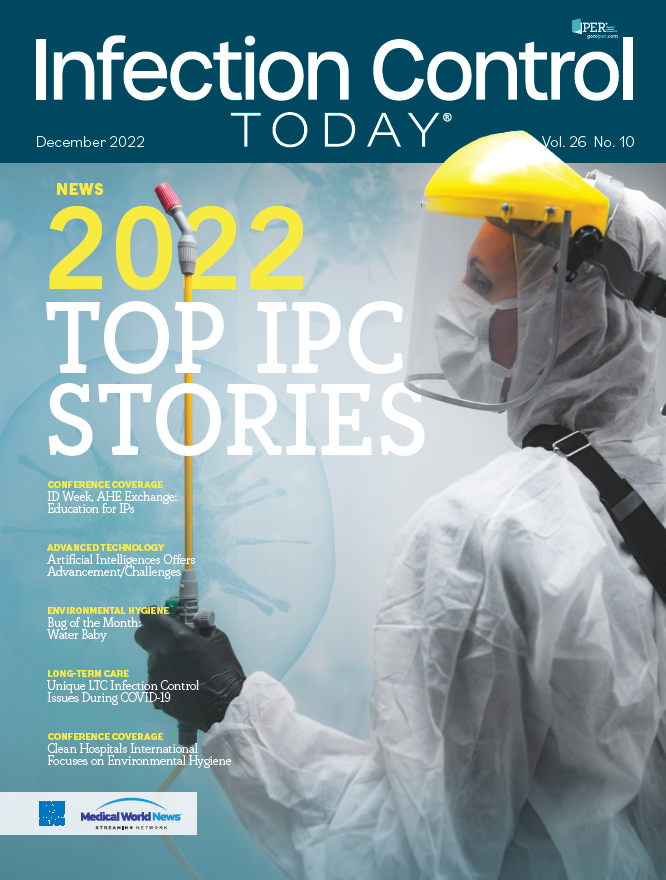Artificial Intelligence Offers Advancements and Challenges in the IPC Sphere
Artificial intelligence increases infection prevention and control measures in health care facilities and beyond.
Artificial intelligence can be very useful in infection control and prevention; however, there are challenges to be overcome.
(Adobe Stock)

The use of artificial intelligence (AI) (ie, machine learning) has been a growing mainstay in infection prevention and control (IPC). The advantages are many, including consistency, speed, and the ability to handle massive amounts of data. However, although the positive attributes of AI handling IPC continue to be measured, there are a significant number of challenges involved. Representative datasets should be of high quality, and biases within preexisting databases must be considered.
AI offers tremendous potential for infection control. The National Center for Biotechnology Information states that AI can potentially locate transmission events during outbreaks. Predicting patients at high risk of infection is another advantage of AI and would hone IPC intervention. Studies have explored laboratory infection diagnosis and epidemiology.
Further exploration may reveal as-yet-undiscovered benefits of AI, which also offers:
- objective pattern recognition, which can enhance diagnostics,
- standardized diagnostics, and
- help in disseminating IPC expertise.
Studies show that hand hygiene apps, such as SureWash, will require further evaluation within varied clinical scenarios.1-3 However, these handwashing apps can deliver a change in habits, especially for staff members who have grown to depend on electronic reminders. When feedback is removed, performance tends to return to baseline. “In an outpatient setting, [although] machine learning with feedback was associated with improvements in staff hand hygiene before first patient contact, concerns regarding accuracy, long-term sustainability, and user fatigue from repeated notifications were noted,” according to Fitzpatrick et al, in a recent study.2
AI in the ICU
According to a review from the Annual Update in Intensive Care and Emergency Medicine 2022, research and development in the intensive care unit (ICU) is at an all-time high.1 To date, the implementation of AI into clinical practice has been inconsistent, but the results are promising. An increase in studies seems inevitable with the expected growth in the use of AI.
An urgent need within the ICU is to optimize infection management because patients require treatment that is adequate and timely. Inadequate management of infection can result in increased mortality rates.1 With antimicrobial resistance on the rise, the need for near-immediate and accurate diagnosing is vital. The primary focus of AI within the ICU has been advancing the infection management field, addressing the potential for sepsis, and more recently, addressing the potential for COVID-19.
Antimicrobial Therapy
Many AI models attempt to forecast an event, such as sepsis, central line–associated bloodstream infections, and ventilator-associated pneumonia (VAP). These prediction models have been developed using routine health care data stored within databases. The prediction models, in theory, can give the physician opportunity to address risk factors. If the event cannot be prevented, a prediction model can offer a chance to monitor the patient and treat them appropriately in a timely manner. The success of these predictive algorithms has shown an overall potential to decrease infection-related morbidity and mortality.
Although antimicrobials are still prescribed for patients who do not need it, machine learning may help identify patients who are less inclined to develop bacterial infection. These patients are suited to discontinue antimicrobials altogether. The best performing AI models in this effort identified patients at low risk of infection with a negative predictive value of more than 93%.1
Diagnostic Accuracy
Although some infections are straightforward and well described, others may harbor symptoms that are subtle and more subject to interpretation.1 For example, VAP can present various combinations of symptoms, microbiological anomalies, radiographic features, and biochemical results. The AI assistant has been shown to improve objectivity and, when combined with human evaluation, improve diagnostic accuracy. New diagnostic techniques, such as electronic nose sensor signals when diagnosing VAP, have established good accuracy with AI. In addition, AI has been good at erasing the human-imposed hard line between infection and noninfection. AI can help classify the middle ground (ie, borderline infection). The time saved in this process can be extremely significant for treatment and healing.
Inflammation vs Bacterial Infection
Determining whether a patient has an infection or systemic inflammation without infection can be tricky because both diseases have different data types to review, abnormal values are common, and current discriminative tests are lacking. Antimicrobials are commonly prescribed, but the causative pathogen is learned long after therapy has begun.1 According to investigators, AI machine learning can play a role in rapidly identifying the pathogen and its antimicrobial susceptibility right from clinical samples within approximately 30 minutes. This would lead to more timely and appropriate treatment, possibly allowing an adjustment to the antimicrobial dose before the second one is administered.
TM Rawson et al supervised machine learning models to support the diagnosis of bacterial infection using only blood test results.4 This became a significant tool in the context of COVID-19, with the difficulty in diagnosing coinfection of bacterial origin. The algorithms are still in evaluation phase, but initial trials are encouraging.2
Bacterial Species Detection
AI is proving to be useful in finding species of bacteria without the need for culture or incubation period, using limited samples of urine, sputum, or blood. This technique has the potential to reduce time identifying antimicrobial resistance and offers a high accuracy rate for certain infections. AI can identify most urinary tract infections, antibiotic susceptibility, and the 30 most common bacterial and yeast isolate classes presented in the ICU worldwide.
With these efforts come the development of prediction models. These models are helpful for predicting the causative organism or antimicrobial resistance. Such models may become useful in low- and middle-income countries. One example is a study in Cambodia at a children’s hospital, performed by Oonsivilai et al,5 using only variables from clinical data, demographics, and living conditions.
Turnaround Time
Researchers are currently exploring machine learning apps in all aspects of the microbiology laboratory. Most of these AI models are geared toward identifying microorganisms and evaluating antimicrobial resistance, always in hopes of reducing the essential turnaround time.
Prescription review is another area under scrutiny. Parameters such as dosage, route of administration, and duration are included. These systems are time intensive and subject to changing guidelines.
The Future of AI for IPC
Although research on machine learning continues to expand in the field of infection prevention, clinical implementation remains sporadic. Most models are still in the prototype stage. Because these models are designed for trials, validating them in external datasets will be a challenge. “IPC and health care generally need to become less fragmented to access these technologies. This is essential to train AI applications appropriate for a particular context and ensures that the algorithms perform consistently across patient cohorts, especially those [that] may not have been adequately represented in the training set,” wrote Fitzpatrick et al in a study using AI in IPC.2
The Human Factor
It’s universally agreed that nothing can replace the warmth of a caring health care professional. Although there appears to be infinite potential for AI as a tool within the infection control arena, a decision must be made about what health care professionals consider sufficient for using AI in clinical practice. Beyond the variables involved in treatment of individuals, other factors to consider include legal and ethical ramifications. Physicians must be educated and encouraged to evaluate AI model abilities and studies associated with AI. It is crucial that AI be regarded as a tool and not an end user. The limitations and biases within AI and the possibility of failure are real, and it is the responsibility of the medical professional to ensure the safety of the patient.
- De Corte T, Van Hoecke S, De Waele J. Artificial intelligence in infection management in the ICU. Crit Care. 2022;26(1):79. doi:10.1186/s13054-022-03916-2
- Fitzpatrick F, Doherty A, Lacey G. Using artificial intelligence in infection prevention. Curr Treat Options Infect Dis. 2020;12(2):135-144. doi:10.1007/s40506-020-00216-7
- Whitacre Martonicz TL. Thermal imaging to increase hand hygiene adherence. Infection Control Today®. October 14, 2022. Accessed October 26, 2022. https://www.infectioncontroltoday.com/view/thermal-imaging-to-increase-hand-hygiene-adherence
- Rawson TM, Hernandez B, Wilson RC, et al. Supervised machine learning to support the diagnosis of bacterial infection in the context of COVID-19. JAC Antimicrob Resist. 2021;3:dlab002.
- Oonsivilai M, Mo Y, Luangasanatip N, et al. Using machine learning to guide targeted and locally-tailored empiric antibiotic prescribing in a children’s hospital in Cambodia. Wellcome Open Res. 2018;3:131. doi:10.12688/wellcomeopenres.14847.1

Show, Tell, Teach: Elevating EVS Training Through Cognitive Science and Performance Coaching
April 25th 2025Training EVS workers for hygiene excellence demands more than manuals—it requires active engagement, motor skills coaching, and teach-back techniques to reduce HAIs and improve patient outcomes.
The Rise of Disposable Products in Health Care Cleaning and Linens
April 25th 2025Health care-associated infections are driving a shift toward disposable microfiber cloths, mop pads, and curtains—offering infection prevention, regulatory compliance, and operational efficiency in one-time-use solutions.
Phage Therapy’s Future: Tackling Antimicrobial Resistance With Precision Viruses
April 24th 2025Bacteriophage therapy presents a promising alternative to antibiotics, especially as antimicrobial resistance continues to increase. Dr. Ran Nir-Paz discusses its potential, challenges, and future applications in this technology.